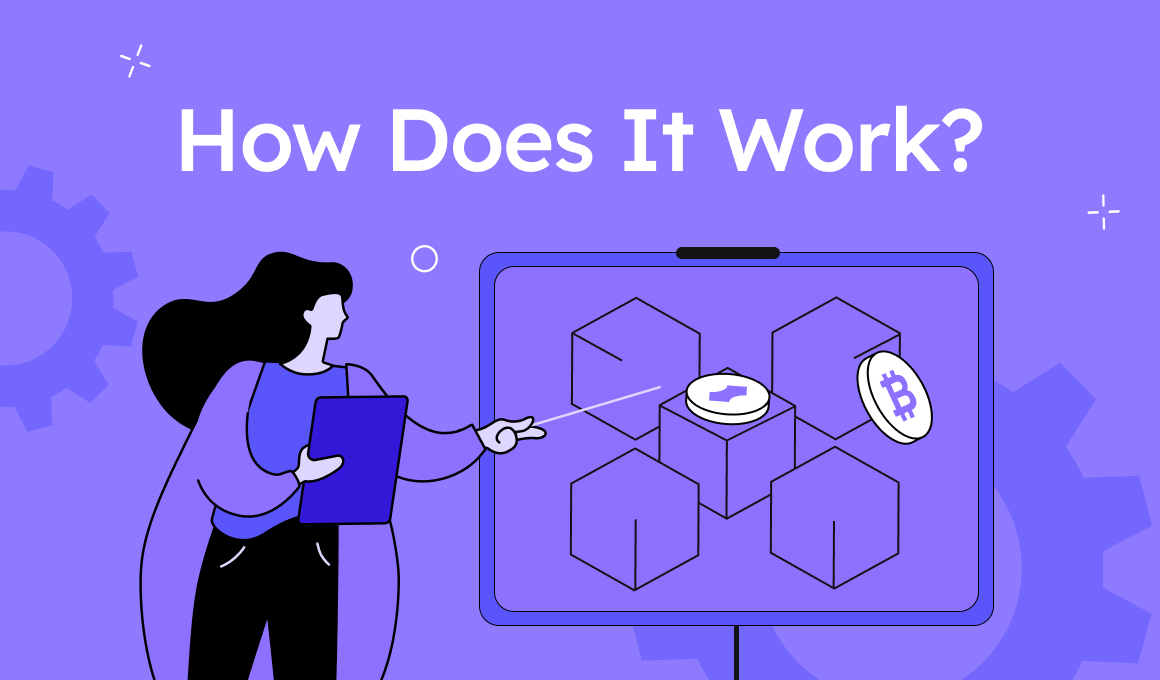Blockchain technology is a digital ledger that allows people to store and exchange information in a secure, transparent, and decentralized way. But how does it actually work? In this beginner’s guide, we’ll break down the key components of blockchain technology and explain how they work together to create a secure and reliable system.
Blockchain structure
First, let’s talk about the structure of a blockchain. A blockchain is essentially a series of blocks, i.e., chunks of data stored in digital format, that are linked together in a chronological order. New transactions enter blocks via the work provided by miners, and the nodes of the network keep it secure, running, and verify its authenticity. The three fundamental components of a blockchain are thus blocks, nodes, and miners.
Let’s explore each one separately.
Blocks
In blockchain technology, blocks are the basic building… blocks (hah) of the digital ledger. Each block contains a set of transactions, and a unique code called a hash that serves as a digital signature. When a new transaction occurs, it is broadcast to the network of nodes that make up the blockchain. These nodes then verify the transaction to ensure that it is legitimate and that the person making the transaction has the necessary funds.
Once the transaction has been verified, it is added to a new block along with other verified transactions. Each block is assigned a unique hash that is created using a mathematical function that converts the data in the block into a fixed-length string of characters. This hash serves as a unique identifier for the block and helps ensure that the information stored in the block cannot be tampered with or altered.
In order to add a new block to the blockchain, nodes on the network must solve a complex mathematical problem known as a proof-of-work (PoW) puzzle. This requires a significant amount of computational power and energy, which makes it difficult for anyone to add a fraudulent block to the blockchain. Once a node solves the puzzle, the new block is added to the blockchain and the process begins again with a new set of transactions.
Each block in the blockchain is linked to the previous block, creating a chain of blocks that stretches back to the very first block in the chain. This linking is achieved by including the hash of the previous block in the current block. By linking each block to the one before it, the blockchain creates a tamper-proof and secure system that cannot be easily altered.
One of the key benefits of blockchain technology is its transparency. Because every transaction is recorded and verified by nodes on the network, it is possible to trace the history of any given asset or transaction back to its origin. This makes it easier to track the movement of goods and money, which can be especially useful in industries like supply chain management or international finance.
Nodes
A node is any device connected to the blockchain network that can store, validate and communicate transactions. Nodes work together to maintain the integrity and security of the blockchain by sharing information and verifying transactions. Each node has a copy of the entire blockchain, which helps ensure that no one can alter the blockchain’s history without detection.
Blockchain nodes are the individual computers or servers that participate in the validation and verification of transactions on a blockchain network. These nodes are responsible for storing and maintaining a copy of the blockchain ledger, which is a distributed and decentralized database that records all transactions and other activities on the network.
There are different types of nodes on a blockchain network, including full nodes, light nodes, and miner nodes. Full nodes have a complete copy of the blockchain ledger and participate in the consensus process, validating and verifying transactions and blocks. Light nodes, on the other hand, only store a small part of the blockchain ledger and rely on full nodes for validation and verification. Miner nodes are responsible for solving complex mathematical algorithms to validate transactions and add new blocks to the blockchain.
Nodes communicate with each other through a peer-to-peer network, enabling the synchronization and updating of the blockchain ledger across the network. The decentralization of nodes on a blockchain network means that there is no single point of control or failure, making the network more secure and resistant to hacking or tampering.
In summary, blockchain nodes are essential components of the blockchain network, responsible for maintaining the integrity and security of the network by validating and verifying transactions and blocks.
Miners
Miners are participants in a blockchain network who use their computing power to validate transactions and add new blocks to the blockchain.
When a user initiates a transaction on a blockchain network, it is broadcast to all nodes on the network. The transaction is then verified by multiple nodes to ensure that it is legitimate and does not conflict with other transactions on the network. Once the transaction is verified, it is grouped with other transactions to form a block.
Miners then compete to solve a complex mathematical algorithm, known as a proof-of-work algorithm, to validate the block and add it to the blockchain. The first miner to solve the algorithm is rewarded with cryptocurrency tokens and the right to add the new block to the blockchain.
The mining process is essential to the security and integrity of a blockchain network. By requiring miners to invest computing power in solving complex algorithms, the network ensures that it is difficult and resource-intensive to tamper with the blockchain. Additionally, the decentralized nature of mining means that there is no single point of control or failure, making the network more secure and resistant to attack.
Together, blocks, nodes, and miners form the foundation of a blockchain system, providing a secure, decentralized, and transparent way to conduct transactions without the need for intermediaries.
Now let’s see the process in action
The process of adding transactions to the blockchain involves several steps, including mining and block validation. Here is an overview of the process:
- A user initiates a transaction by creating a digital record of the transaction and signing it with their private key.
- The transaction is broadcast to the blockchain network, where it is received by the nodes. Each node verifies the transaction to ensure that it is valid, and then adds it to their copy of the blockchain.
- Miners receive a batch of transactions from the network and attempt to create a new block by solving a complex mathematical problem – the mining process. The first miner to solve the problem creates a new block and broadcasts it to the network.
- Other miners verify the block by confirming that it contains valid transactions and adheres to the blockchain’s rules. If the block is deemed valid, it is added to their copy of the blockchain, and the process starts again.
- The transactions contained within the block are considered confirmed, and the cryptocurrency associated with the transaction is transferred from the sender’s wallet to the recipient’s wallet.
Smart contracts – a fundamental part of blockchain technology
Smart contracts are self-executing contracts that run on a blockchain network. They are a key feature of blockchain technology because they enable the automation of contract execution, reducing the need for intermediaries and increasing efficiency and transparency. Here’s how smart contracts are used in blockchain applications:
- Automation of Contract Execution: Smart contracts can automate the fulfillment of contracts by automatically executing terms and conditions once pre-defined criteria are met. For example, a smart contract could automatically transfer funds from one party to another once certain conditions are met, such as the delivery of goods or completion of services.
- Increased Transparency: Smart contracts are stored on the blockchain, making them transparent and immutable. This means that all parties involved in a contract can view and verify the terms of the contract and the execution of the contract, increasing trust and transparency.
- Reduced Costs: Smart contracts eliminate the need for intermediaries such as lawyers, banks, and other third-party services, reducing transaction costs and increasing efficiency.
Smart contracts are one of blockchain technology’s most powerful features that enables automation, transparency, and efficiency, with an ever-expanding number of use cases and applications.
What is a blockchain consensus mechanism?
Blockchain consensus mechanisms are the mechanisms used by a blockchain network to ensure that all nodes on the network agree on the state of the blockchain.
Consensus is a critical aspect of blockchain technology because it ensures that the data stored on the blockchain is accurate, trustworthy, and tamper-proof. It also defines how new blocks are added to the chain.
There are several types of consensus mechanisms used in blockchain networks, and these are the three most common. The list is not exhaustive, but we will have a separate article for that.
Proof-of-Work (PoW)
PoW is the most well-known consensus mechanism, used by Bitcoin and several other blockchain networks. It requires miners to solve complex mathematical puzzles to validate transactions and add new blocks to the blockchain. The first miner to solve the puzzle is rewarded with a certain amount of cryptocurrency and is allowed to add a new block to the blockchain. To solve the puzzle, miners use their computational power to perform a brute-force search, trying different combinations of input values until they find a hash that meets the required criteria.
One of the main advantages of PoW is that it provides a high degree of security, as it is very difficult to manipulate the blockchain by altering past transactions.
Proof-of-Stake (PoS)
PoS is an alternative consensus mechanism that is less resource-intensive than PoW. In a PoS system, participants stake their cryptocurrency tokens as collateral and are chosen to validate transactions and add new blocks to the blockchain based on the amount of tokens they have staked. This means that the more tokens a participant has, the more likely they are to be chosen to validate transactions.
One of the main advantages of PoS is that it is more energy-efficient and cost-effective than PoW since it does not require the same level of computational power and electricity consumption.
Delegated Proof-of-Stake (DPoS)
DPoS is a variant of PoS that introduces a layer of representative democracy into the consensus mechanism. Participants vote for representatives who then validate transactions and add new blocks to the blockchain on their behalf. This system is faster and more efficient than traditional PoS and PoW mechanisms.
Conclusion
There you have it – by now you should have a solid understanding of the basic way a blockchain operates, its constituent parts, and the processes involved in its functioning. But the rabbit hole goes deep – follow us for more educational content and keep learning.






